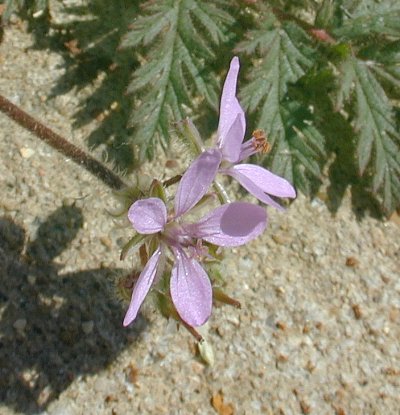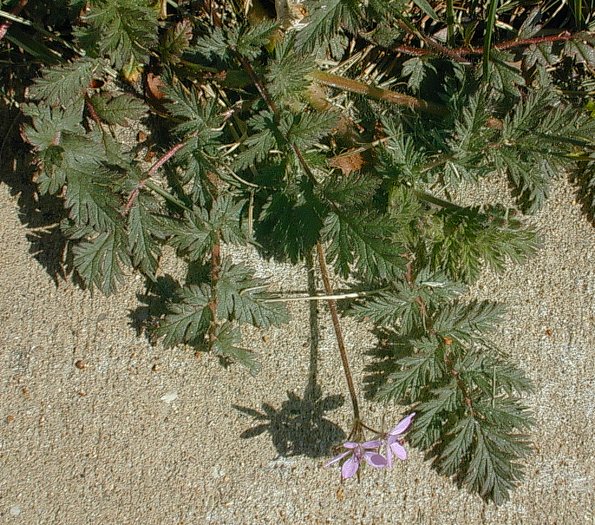Description: This plant is a winter annual or biennial. It forms a rosette of basal leaves that spans ½–1½' across, and produces flowering stems up to 1' tall that have few or no leaves. These stems have a tendency to sprawl in the absence of supportive vegetation. They are usually reddish green or reddish brown, circular in circumference, and covered with long white hairs. The basal leaves are up to 8" long and 2½" across. They are odd-pinnate and have long petioles. Both the central stalk of these compound leaves and their petioles are reddish green or reddish brown and covered with long white hairs, like the stems. The hairy leaflets are up to 1" long and ½" across. They are pinnately cleft and have both shallow and deep lobes. Their margins are ciliate. The cauline leaves are similar to the basal leaves, but they are smaller in size and have shorter petioles. At the base of each cauline leaf, there is a pair of small stipules that are ovate in shape. Each flowering stem terminates in an umbel of about 4-8 flowers. Only 1 or 2 of the flowers in an umbel are in bloom at the same time. Each flower is up to ½" across, consisting of 5 pink or purplish pink petals, 5 hairy green sepals, 10 stamens (5 fertile, 5 infertile), and 5 united styles with purple stigmas in the center.

The blooming
period occurs from late spring to early summer for 1-2 months, although
a few plants may bloom later. There is no noticeable floral scent. Each
flower develops into a seed capsule in the form of a long narrow beak
up to 1½" long. Upon maturity, this seed capsule splits apart into 5
narrow linear segments. Each of these segments has a single seed at the
bottom. Each seed is rather linear in shape, somewhat broader at the
top and tapering to a point at the bottom. As the attached segment
begins to dry, it forms an irregular spiral that can drive the seed
into the ground. The root system consists of a taproot. This plant
spreads by reseeding itself, and often forms colonies.
Cultivation:
Storksbill is generally found in full sun and mesic to dry conditions.
It grows quite well in the loam or clay-loam of gardens and lawns, and
probably other kinds of soil as well. This plant is able to withstand
regular mowing of lawns because of the prostrate habit of the basal
leaves.
Range & Habitat:
The non-native Storksbill is an uncommon plant that occurs in only a
few counties in
NE Illinois and elsewhere within the state (see Distribution
Map). It is
probably more common in other areas of the United States, such as the
south, southwest, and Pacific coast. In the southwestern states,
Storksbill has been introduced as a source of forage, otherwise it is
adventive from the Mediterranean area, where it is native. Habitats
include lawns, areas adjacent to sidewalks, fields, and sunny waste
areas that have little vegetation. So far, this plant has not invaded
natural areas in Illinois.

Faunal
Associations:
Small bees and flies visit the flowers for nectar or pollen. Some
insects feed on the foliage and other parts of this plant. For example,
Acyrthosiphon malvae
(Geranium Aphid) sucks the plant sap, while Melanoplus foedus
(Striped Sand Grasshopper) eats the foliage (Blackman & Eastop,
2013; Wyoming Agr. Exp. Station, 1994). In the
drier western states, where this plant is more common, the seeds are
eaten by upland gamebirds, granivorous songbirds, and small rodents,
such as kangaroo rats (Martin et al., 1951/1961). The foliage is
palatable and readily eaten by
various hoofed browsers and rabbits, including domestic livestock
(Georgia, 1913).
Photographic Location:
At the edge of a lawn along a sidewalk in Urbana, Illinois.
Comments:
Storksbill is the only Erodium sp. that is known to
occur in Illinois. There are other Erodium spp.
(Storksbill species), both native and introduced, that can be found in
the western and SW states, but they don't occur in Illinois. Species in
this genus are closely related to Geranium spp.
(Cranesbill species) and both groups of plants develop beak-like seed
capsules. However, the leaves of Storksbill species are pinnately
compound, while the leaves of Cranesbill species are palmate.